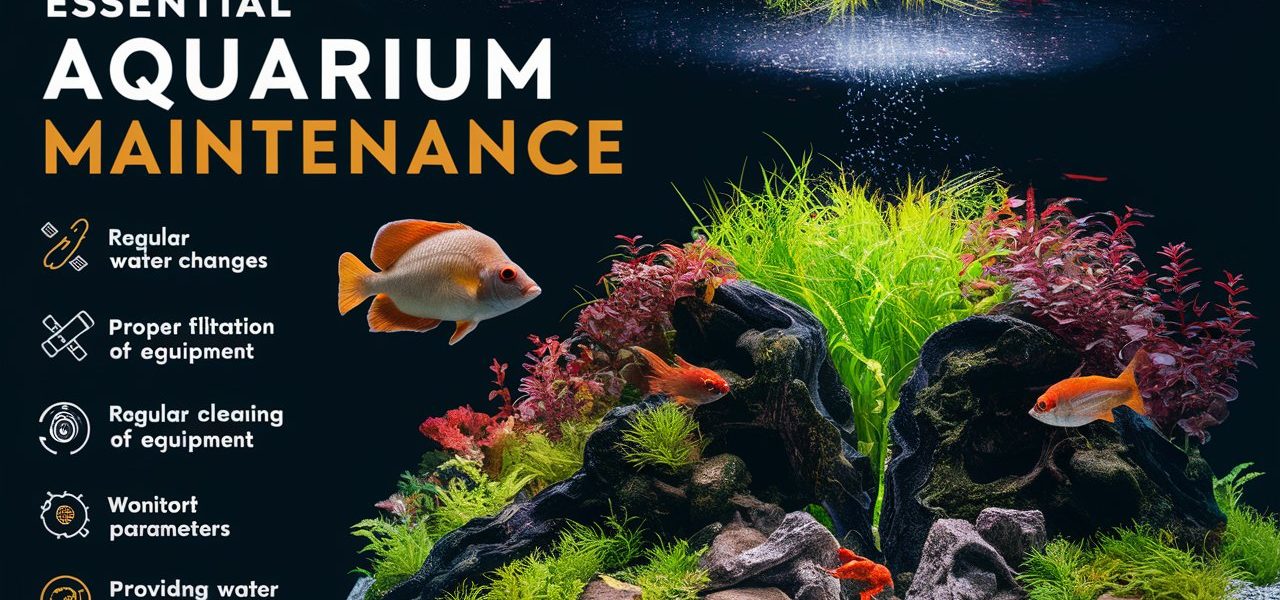Maintaining an aquarium is a rewarding hobby that brings a slice of aquatic life into your home. However, to ensure that your underwater ecosystem thrives, it is essential to keep your tank clean and well-maintained. Proper aquarium maintenance not only enhances the aesthetic appeal of your tank but also promotes a healthy environment for your fish and plants. In this comprehensive guide, we will explore various aquarium maintenance tips to help you keep your tank sparkling clean. From routine cleaning schedules to advanced filtration techniques, we’ve got you covered.
Understanding the Basics of Aquarium Maintenance
Importance of Regular Maintenance
Regular maintenance is crucial for the health and longevity of your aquarium. Without proper care, harmful toxins can accumulate, leading to a decline in water quality and the health of your aquatic inhabitants. Regular maintenance helps prevent these issues by ensuring that the tank environment remains stable and clean.
Essential Tools for Aquarium Maintenance
Having the right tools can make aquarium maintenance more efficient and effective. Here are some essential tools you should have on hand:
- Gravel Vacuum: Helps in cleaning the substrate and removing debris.
- Algae Scraper: Keeps the tank walls free from algae buildup.
- Water Test Kits: Monitors water parameters such as pH, ammonia, nitrite, and nitrate levels.
- Buckets and Siphons: Essential for water changes and cleaning tasks.
- Filter Media: Ensures proper filtration and water quality.
Creating a Maintenance Schedule
Daily Tasks
Performing daily maintenance tasks can help you stay on top of potential issues and ensure the well-being of your aquarium:
- Check Water Temperature: Ensure the water temperature remains stable within the ideal range for your fish species.
- Inspect Fish Behavior: Observe your fish for any signs of stress or illness.
- Remove Uneaten Food: Prevent food from decomposing and contaminating the water.
Weekly Tasks
Weekly maintenance tasks are essential for keeping your tank clean and healthy:
- Water Changes: Replace 10-20% of the water to remove toxins and replenish essential minerals.
- Gravel Vacuuming: Clean the substrate to remove debris and waste.
- Algae Removal: Scrape off algae from the tank walls and decorations.
Monthly Tasks
Monthly tasks help maintain the overall health of your aquarium:
- Filter Maintenance: Clean or replace filter media to ensure efficient filtration.
- Check Equipment: Inspect heaters, lights, and other equipment for proper functioning.
- Test Water Parameters: Conduct a comprehensive water test to monitor pH, hardness, and other critical parameters.
Advanced Filtration Techniques
Mechanical Filtration
Mechanical filtration involves removing physical debris from the water. It typically uses filter pads or sponges to trap particles, keeping the water clear and free of contaminants.
Biological Filtration
Biological filtration relies on beneficial bacteria to break down harmful substances like ammonia and nitrites. This process converts these toxins into less harmful nitrates, which are then removed during water changes.
Chemical Filtration
Chemical filtration uses activated carbon or other chemical media to remove dissolved organic compounds, odors, and discoloration from the water. This type of filtration helps maintain water clarity and quality.
UV Sterilization
UV sterilization uses ultraviolet light to kill harmful microorganisms and algae spores. This method is particularly useful in preventing the spread of diseases and keeping the water crystal clear.
Common Maintenance Mistakes to Avoid
Overfeeding
Overfeeding is one of the most common mistakes aquarium owners make. Excess food can decompose and release harmful toxins into the water, leading to poor water quality and health issues for your fish. Feed your fish small amounts that they can consume within a few minutes, and remove any uneaten food promptly.
Neglecting Water Changes
Skipping regular water changes can result in the accumulation of toxins and a decline in water quality. Make water changes a priority in your maintenance routine to keep your aquarium environment healthy.
Using Tap Water Without Treatment
Tap water often contains chlorine and other chemicals that are harmful to fish. Always treat tap water with a de-chlorinator before adding it to your tank to neutralize these harmful substances.
Ignoring Equipment Maintenance
Regularly inspect and maintain your aquarium equipment to ensure it functions correctly. Clean filters, check heaters, and replace any faulty equipment to prevent issues that could harm your aquatic life.
Tips for Algae Control
Controlling Light Exposure
Algae thrive in environments with excessive light. Control algae growth by limiting the amount of light your tank receives. Use a timer to ensure your aquarium lights are on for 8-10 hours a day, and avoid placing the tank in direct sunlight.
Introducing Algae-Eating Fish and Invertebrates
Adding algae-eating fish and invertebrates, such as Siamese algae eaters, otocinclus catfish, and snails, can help keep algae levels under control. These creatures naturally graze on algae, reducing its growth in your tank.
Regular Algae Scraping
Regularly scraping algae from the tank walls and decorations can prevent it from becoming a nuisance. Use an algae scraper or pad to keep surfaces clean and free from buildup.
Maintaining Water Quality
Testing Water Parameters
Regularly test your aquarium water to ensure it remains within the optimal parameters for your fish species. Monitor pH, ammonia, nitrite, nitrate, and hardness levels, and make adjustments as needed.
Using Water Conditioners
Water conditioners can help maintain water quality by neutralizing harmful substances and adding beneficial elements. Use conditioners as directed to keep your tank water safe and healthy for your fish.
Implementing Biological Filtration
Biological filtration is essential for maintaining water quality. Ensure your tank has a well-established biological filter, and avoid cleaning filter media too thoroughly to preserve beneficial bacteria.
Ensuring Proper Aeration
Using Air Pumps and Airstones
Air pumps and airstones increase oxygen levels in your aquarium by promoting water circulation and gas exchange. Ensure your tank has adequate aeration to support the health of your fish and beneficial bacteria.
Positioning Equipment Correctly
Properly position your filter outlets, air stones, and other equipment to maximize water movement and oxygenation. This helps maintain a healthy environment for your aquatic inhabitants.
Avoiding Overcrowding
Overcrowding can lead to oxygen depletion and poor water quality. Ensure your tank is appropriately stocked based on its size and the needs of your fish species.
Managing Plant Growth
Choosing the Right Plants
Select plants that are compatible with your tank’s conditions and your fish species. Consider factors such as lighting, substrate, and water parameters when choosing plants.
Regular Pruning
Regularly prune your aquarium plants to prevent overgrowth and maintain a healthy, balanced ecosystem. Remove dead or decaying leaves to prevent them from decomposing and releasing toxins into the water.
Using Fertilizers
Aquarium plants may require fertilizers to thrive. Use fertilizers designed for aquatic plants to provide essential nutrients without harming your fish.
Dealing with Common Aquarium Problems
Cloudy Water
Cloudy water can result from various issues, including overfeeding, poor filtration, and bacteria blooms. Address the underlying cause and take corrective measures such as performing water changes and improving filtration.
Fish Illness
Monitor your fish for signs of illness, such as abnormal behavior, discoloration, and fin damage. Quarantine sick fish and treat them with appropriate medications to prevent the spread of disease.
Algae Blooms
Algae blooms can quickly take over your tank, reducing water quality and aesthetics. Control algae growth by managing light exposure, adding algae-eating fish, and performing regular maintenance.
Aquarium Fish and Diet
Feeding your aquarium fish the right diet is crucial for their health and well-being. Different species have specific dietary needs, and providing a balanced diet helps prevent nutrient deficiencies and overfeeding. Be sure to research the dietary requirements of your fish and adjust feeding practices accordingly to maintain a clean and healthy tank.
Conclusion
Maintaining a clean and healthy aquarium requires dedication and regular attention to detail. By following these aquarium maintenance tips, you can create a thriving aquatic environment for your fish and plants. Remember to establish a consistent maintenance schedule, monitor water quality, and address any issues promptly. With proper care, your aquarium will remain a beautiful and vibrant centerpiece in your home.





